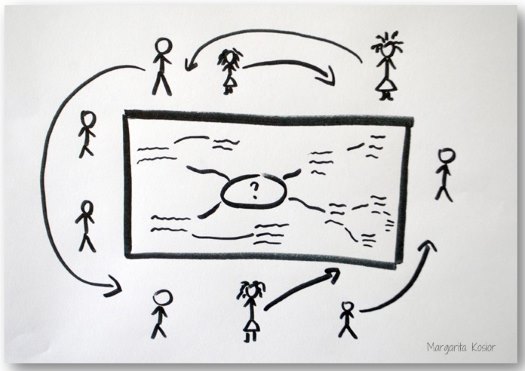The Bigger, the Better: Teaching With a Big Roll of Wrapping Paper
Margarita Kosior, Greece
Margarita Kosior, born in Poland and based in Greece, is a passionate storyteller. She is a tertiary educator teaching Academic English and Language Teaching Methodology at BA and MA levels. She is also interested in ELT at the pre-K level. As an advocate for social justice, she believes in spreading awareness of global issues through ELT. As a mother of two bilingual children, she is a strong supporter of bilingual and multilingual education. As a curious trend-spotter, she is always on the lookout for current approaches and methods in language teaching. E-mail: margaritakosior@gmail.com

Menu
Introduction
Silent discussion
Mural
Conclusion
Substantial amount of research has been conducted to prove the effectiveness of using songs, stories, art, drama, technology, or poetry in ELT. They boost creativity, increase motivation and engagement; the benefits are there and we know it. We also know, however, that a creative mind can turn anything into a piece of art: a piece of paper into a boat or a paper flower, a plastic bottle cup into an insect, etc. When the creative spirit it there, anything is possible. In this spirit, something as trivial as a big roll of wrapping paper, also referred to simply as BIG paper, can be used to improve student learning experience. Versatile, fun to use, wrapping paper roll can change into canvas, a huge notebook, or a platform for exchanging ideas. You can paint on it, draw on it, lie down on it and have your body outlined on it, create a map and walk on it, draw a series of events and tell a story or turn it into a mural for class display.
Big paper can be used with any age group in a variety of ways either during the warm-up stage of a lesson or as a follow-up activity. With older students, it can be used for silent discussions. Younger ones love making murals based on stories told during our storytelling sessions.
Silent discussion is a collaborative learning strategy which helps students explore a topic in depth, but most importantly, it allows each student to work at their own pace and engages even the most intimidated students. It first takes form of written self-expression and exchange of ideas ultimately turns into a verbal discussion. The instructions need to be very clear: the participants are not allowed to talk during steps 1, 2 and 3. The only means of communication among them is a long stretch of big wrapping paper and markers.
Step 1
A silent discussion gets generated around a stimulus selected by the teacher. It can be a word, an image, a startling fact, or a quote which will arouse curiosity and serve as a springboard for discussion.
Step 2
The participants need to know the time limit. It is recommended that a silent discussion lasts at least 15 minutes. It is especially important in case of groups of students who are not familiar with this type of activity and need some time to get used to it. They will have to understand that silence plays an important role in the process and gives them an opportunity to think, "listen", respond, reflect, ask questions and answer questions posed by other participants.
Step 3
The group receives a big paper and markers in various colors. After the students have read the hint/stimulus, they start making written comments, asking questions and responding to questions posed by others by connecting these questions, answers and comments with lines. The outcome looks similar to a big mind map. It is important that the students know that a silent discussion is not a turn-taking activity; all students can be engaged in it simultaneously, which creates the atmosphere of a creative mess.
Step 4
Once the time is up, the students are given some time to step back, walk around and read through the whole discussion, identifying different areas and noticing how the conversation has got organized around certain points/topic statements.

Step 5
A regular discussion begins during which the participants draw conclusions from the silent stage of the activity. It is interesting to notice that even the shyest in the group are more confident to speak up and get their voices heard.
I have used silent discussion with various groups of students (12+) and I have received positive feedback from all of them. Characteristically, one of my BA Methodology students wrote in one of her journals: "This kind of activity intrigued me as an introvert student who struggles when it comes to answering questions or voicing my opinion. Usually, by the time I have come up with a correctly structured sentence the conversation is either over or the subject has been already changed. This activity was an opportunity for me and other introverted students to take their time and express themselves in a way that is more close to home. I believe that extroverted students enjoyed the activity as well, it was something new, exciting and educational. Change, spicing things up, is always a good choice."
Learning is a multi-sensory process. Wrapping paper allows my older learners to visualize their thinking process and arrange their ideas in a creative way, and it encourages my young and very young learners to engage in creative learning in a variety of ways. One of the ideas is to create murals of stories we tell during our storytelling sessions. I usually pick big books of such classics as "The Rainbow Fish" by Marcus Pfister or "Up, Down, and Around" by Katherine Ayres. There's something about the size of the book and the size of the big paper that encourages children to go wild, cross the borders, go beyond and experiment, and we should not let this go unexploited.
The mural in my classroom is often a visual representation of the story seen through the eyes of the children.
Step 1
During step 1 we complete the telling of a story and think about most vivid images that the students would like to represent on the mural which will later decorate the walls of their classroom.
Step 2
Depending on the age, we either print out coloring templates of the images to be included on the mural (coloring in is easier for very young learners than designing images from scratch), or students come up with their own ideas, pick a place to draw/paint and start creating. We can also cut images and shapes out of color construction paper. In any case, the students decide on the arrangement of items on the BIG paper to create the mural which will best represent the story and on the method they want to use to draw/paint (using paintbrushes, fingers, and toothbrushes, blowing through a straw, or tapping with a sponge).
Step 3
It is important to display the outcome of our students' efforts and make their creative work visible. It makes them proud of their achievements and motivates them to actively participate in the future.
Students at any age whose work gets documented and then projected or exhibited to a wider public become more motivated learners. Students who are allowed to unleash their potential and creativity, and encouraged to think independently and visualize their thinking become more autonomous and responsible learners. Technology helps, other good old methods help, but something as simple as BIG wrapping paper can do miracles, too.
You can find more ideas on how to use BIG paper roll here.
More images illustrating the way in which I have used big paper for silent discussion and creating murals available here.

Please check the Methodology & Language for Primary course at Pilgrims website.
Please check the Creative Methodology for the Classroom course at Pilgrims website.


|